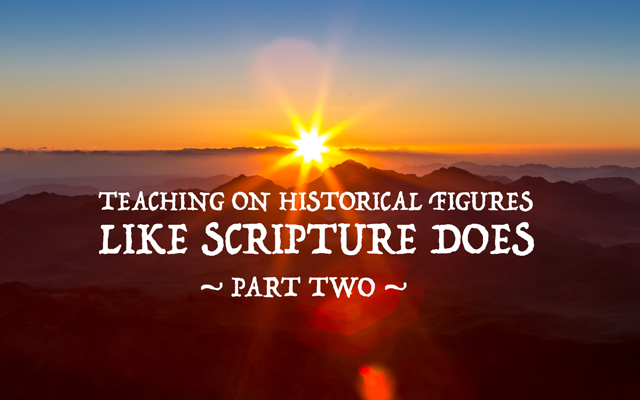Teaching on Historical Figures Like Scripture Does – Part Two


After acquainting us with Moses’ world, he makes his debut on the scriptural pages. As our man takes the stage, the Bible utilizes several storytelling mechanisms that set it apart from traditional methods of teaching history.
Tell me the story or tell me the facts
Getting barebone facts of history is not a problem – until students start falling asleep. If our goal is to stuff brains so they can ace a test, then stick with dry facts. But if our goal is to raise men and women who not only love history, but see themselves as vital players in its drama, then chronological storytelling is our method.
So how does the Bible give us story? In its account of Moses, we see key elements that make a memorable story – and why the Bible is the best story keeper of all time.
The heart of the man
This is where facts-based history falls short. In the biblical record, we learn not only the deeds of the man, we learn his heart. The following passages unveil the fears, questions and desires of Moses with astonishing, eyewitness-account-style detail.
Dialogue Detail
And Moses said, I will now turn aside, and see this great sight, why the bush is not burnt. And when the LORD saw that he turned aside to see, God called unto him out of the midst of the bush, and said, Moses, Moses. And he said, Here am I (Exodus 3:3-4).
Authentic Action
And Moses answered and said, But, behold, they will not believe me, nor hearken unto my voice: for they will say, The LORD hath not appeared unto thee. And the LORD said unto him, What is that in thine hand? And he said, A rod. And he said, Cast it on the ground. And he cast it on the ground, and it became a serpent; and Moses fled from before it (Exodus 4:1-3).
Faltering Faith
And they said unto them, The LORD look upon you, and judge; because ye have made our savour to be abhorred in the eyes of Pharaoh, and in the eyes of his servants, to put a sword in their hand to slay us. And Moses returned unto the LORD, and said, Lord, wherefore hast thou so evil entreated this people? why is it that thou hast sent me? For since I came to Pharaoh to speak in thy name, he hath done evil to this people; neither hast thou delivered thy people at all. (Exodus 5:21-23)
Overcoming Obedience
And Moses and Aaron did as the LORD commanded them, so did they. (Exodus 7:6)
Expressed Emotion
And it came to pass, as soon as he came nigh unto the camp, that he saw the calf, and the dancing: and Moses’ anger waxed hot, and he cast the tables out of his hands, and brake them beneath the mount (Exodus 32:19).
Divine-honoring Desire
Now therefore, I pray thee, if I have found grace in thy sight, shew me now thy way, that I may know thee, that I may find grace in thy sight: and consider that this nation is thy people (Exodus 33:13)
Through dialogue, action and the emotion of chronological story-telling, we learn not only the figure, but the man. This is story that captures the imagination; this is story that captures the heart.
Kenzi Knapp is a follower of Christ, homeschool graduate and student of history. A fourth generation Missourian she enjoys writing about daily life enrolled in Gods great course of faith and His story throughout the ages at her blog, Honey Rock Hills.










































